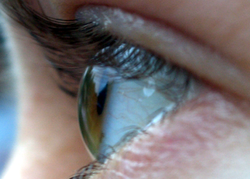Peripheral vision
Peripheral vision is the ability to see objects and movement outside of the direct line of vision.
Functions
The main functions of peripheral vision are:[1]
- recognition of well-known structures and forms with no need to focus.
- identification of similar forms and movements (Gestalt psychology laws)
- delivery of sensations which form the background of detailed visual perception.
Peripheral Vision Media
References
- ↑ Hans-Werner Hunziker, (2006) Im Auge des Lesers: foveale und periphere Wahrnehmung - vom Buchstabieren zur Lesefreude [In the eye of the reader: foveal and peripheral perception - from letter recognition to the joy of reading] Transmedia Stäubli Verlag Zürich 2006 ISBN 978-3-7266-0068-6




